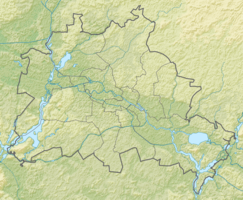Luisenhain (Köpenick)
| Luisenhain Volkspark |
||
|---|---|---|
| Park in Berlin | ||
| Basic data | ||
| place | Berlin | |
| District | Koepenick | |
| Created | 1908 | |
| Newly designed | from 1924 several times | |
| Surrounding streets |
Alt-Köpenick |
|
| Buildings | Ship landing stage | |
| use | ||
| User groups | Foot traffic ; leisure | |
| Park design | ST room a. , Gesellschaft von Landschaftsarchitekten mbH (renovation measures 2004–2007) | |
| Technical specifications | ||
| Parking area | Riverside promenade about 365 m long, on average 45 m wide (between Dahmeufer and the back of the existing buildings) |
|
| building-costs | 1.4 million euros (redesign in the 2000s) | |
|
52 ° 26 '43.8 " N , 13 ° 34' 25.2" E
|
||
The Luisenhain in the Berlin district of Köpenick in the Treptow-Köpenick district is a park in the old town of Köpenick. It is located between the historic town center and the bank of the Dahme opposite the Köpenick Town Hall and was created on the basis of an area donated in 1906 by Köpenick businessman Karl Otto Asseburg (1836–1915) to his municipality at the time.
history
Karl Otto Asseburg, factory owner and merchant in Köpenick, separated part of his property in Schloßstraße (now Alt-Köpenick ) after his sister Luise had died. He gave on 23 June 1906 councilors of that city Cöpenick the property with the condition to demolish the existing buildings, "in honor of my rest in God Sister Luise Asseburg" one in its place Schmuckplatz "lie for all time" and to apply these allow. With the official inauguration of the almost square lawn and flower place in 1908, it was given the name Luisenhain . The city administration was later able to acquire additional adjacent areas, so that the Luisenhain finally extended from the dam bridge to the long bridge at Köpenick Castle .
After Köpenick was incorporated into Greater Berlin , a landing stage for the excursion boats from Berlin was built in the park on the bank of the river . Later, the Köpenick district administration had the sculpture Die Kugelspielerin set up on an area of the Luisenhain , which came from Walter Schott's workshop and showed a woman playing boccia . At the same time, the city gardeners simplified the layout, the riverside path became wider and longer (1928, 1955, 1969). But the trees that were planted first had grown large and shaded the park and especially the riverside path, which was now less inviting for promenades. Most of the view of the river was blocked. In 1950 the bronze sculpture of the ball player disappeared and was never found again; During this time, the theft of non-ferrous metal was a widespread crime in Berlin.
After the political turning point and at the beginning of the 21st century, the newly formed district administration carried out one (provisional) final redesign as part of the Stadtharfe project : According to plans by a Berlin landscape architects' association , twelve old trees and all bushes were removed and the remaining greenery trimmed. The promenade was covered with yellow natural stone slabs with bronze inlays , the other paths, laid out with granite slabs, are kept relatively narrow because they are supposed to remind of the narrow streets in the old town of Köpenick. The bank reinforcement was renewed and a railing was added. Since then, four wide, flat stairs lead down to the water. The work was completed in 2007. In addition, play elements that generate noises, melodies and sounds are installed on some lawns. Benches invite you to linger.
In the Luisenhain there has been the concrete sculpture The Rising by Ingeborg Hunzinger since 1987 (see picture). In 2012 the work of art was dismantled due to its damage and re-erected after the restoration in 2017.
Web links
- Luisenhain with photos and detailed representations.
- Luisenhain at www.stadtentwicklung.berlin.de
Individual evidence
- ↑ Press release of the Treptow-Köpenick District Office , January 23, 2015
- ↑ Luisenhain - a present for Köpenick . In: Berliner Zeitung , May 28, 2018, p. 10.
- ↑ Katrin Bischoff: Stolen, sawed up, sold . In: Berliner Zeitung , January 14, 2019 (print edition), p. 11.
- ↑ Luisenhain on www.koepenick.net; accessed on June 1, 2018.
- ↑ Information from the Senate Department for Urban Development and Housing , accessed on June 1, 2018.
- ↑ "The rising one" is back. In: Berliner Woche , Köpenick edition, April 21, 2017


